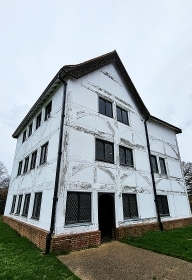The Virgin Queen visited here to watch the hunt in Epping Forest
IT HAS BEEN STANDING for many centuries, but until we saw something about the place in a recent (March 2024) issue of the free Metro newspaper, we did not know it existed. The place is located in Epping Forest on Rangers Road, which runs eastwards from Chingford (on the edge of northeast London). I am referring to a well-preserved, whitewashed, half-timbered Tudor building, which was constructed in 1543 for King Henry VIII, and renovated by his daughter Queen Elizabeth I in 1589.

This edifice, which is 481 years old, is aptly known as ‘Queen Elizabeth’s Hunting Lodge’, and is open to the public to explore. It is a timber-framed three-storey ‘standing’. That is to say that it was constructed to be used as a place from which the hunt could be observed. And Epping Forest, where it stands, was, from the 12th century until the 19th century a Royal Forest, where only the monarch had the right to hunt deer. Although now fully glazed, originally the window apertures on the two upper floors were without glass. Visitors to the lodge would have been able to watch the hunt and, maybe also, shoot animals from these raised vantage points.
Throughout the building, one can see unpainted oak beams – supporting the floors, the walls, the ceilings, and the roof. The ground floor consists of an entrance hall and a larger room (with a fireplace), which served as a kitchen. A wooden staircase leads to the upper floors. It is wrapped around a square hollow newel, which supports the stair treads. There is a glass pyramid (not Tudor) above this space, which allows visitors to see the original lath and plaster work that makes up the newel.
Much of the first floor is occupied by a large hall with windows overlooking the forest. The second floor is similar, but it has a fine hammer-beam ceiling. Another such ceiling is high above the top of the staircase.
During the reign of Queen Victoria, the first floor of the lodge was divided into small bedrooms by partitions, which have long since been removed. It was then used as accommodation by the bailiff of the local lord of the manor. The Watkins family were residents for a period. It was Mrs Harriet Watkins, who used the Lodge and its garden for providing refreshments until 1897, when she took over the adjacent barn – now known as Butler’s Retreat – for the provision of teas. Writing about the lodge in 1876, James Thorne noted:
“The open space in front of the lodge has always been a favourite resort of the East-end holiday folk, for whom ‘tea and refreshments’ are provided at the lodge. On a fine summer’s day, on Monday especially, numerous picnic and ‘van’ parties may be seen, with swings improvised between the oaks, and gipsies with their donkeys in attendance.”
Regarding the suitability of the position of the lodge, he wrote:
“The ground, sloping gently from the lodge on all sides, used to be everywhere unenclosed, the tract beyond being open forest, with some famous unlopped trees, but chiefly, as in other parts of Epping Forest, of pollard oak.”
Today, standing on the second floor, or even on the first, one gets a good panoramic view of the surrounding land.
Queen Elizabeth’s Hunting Lodge is not as grand as some other surviving Tudor buildings (e.g., Hatfield House), but it has been well looked after and it is a remarkable survivor, which is well worth a visit. But before you go, please check the current opening tomes if you wish to explore its interesting interior.



